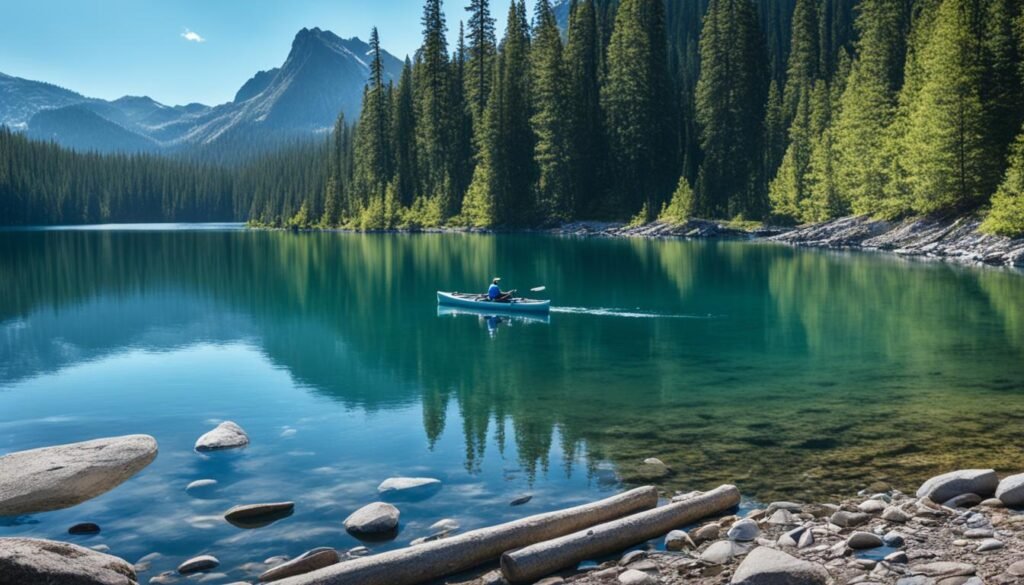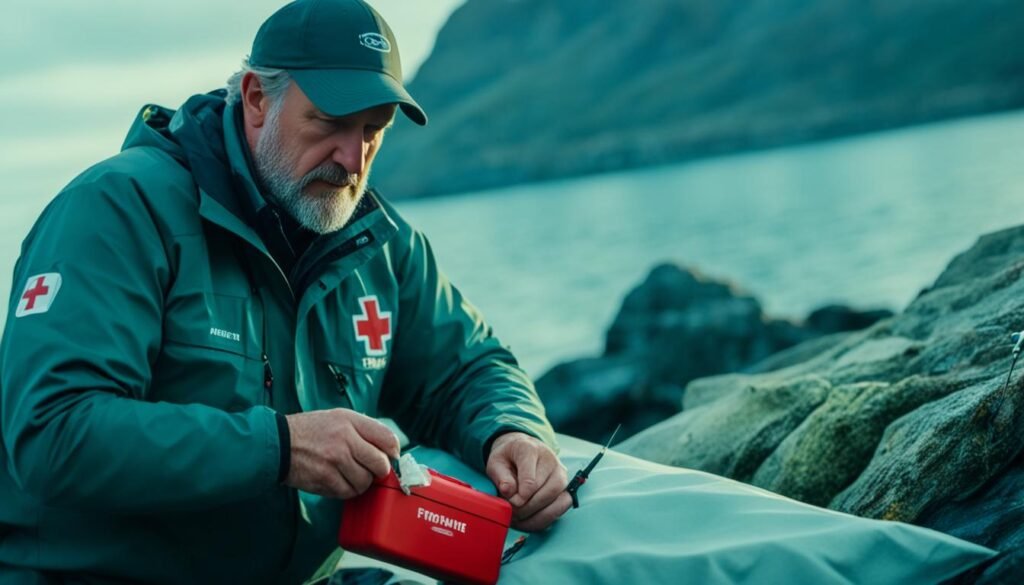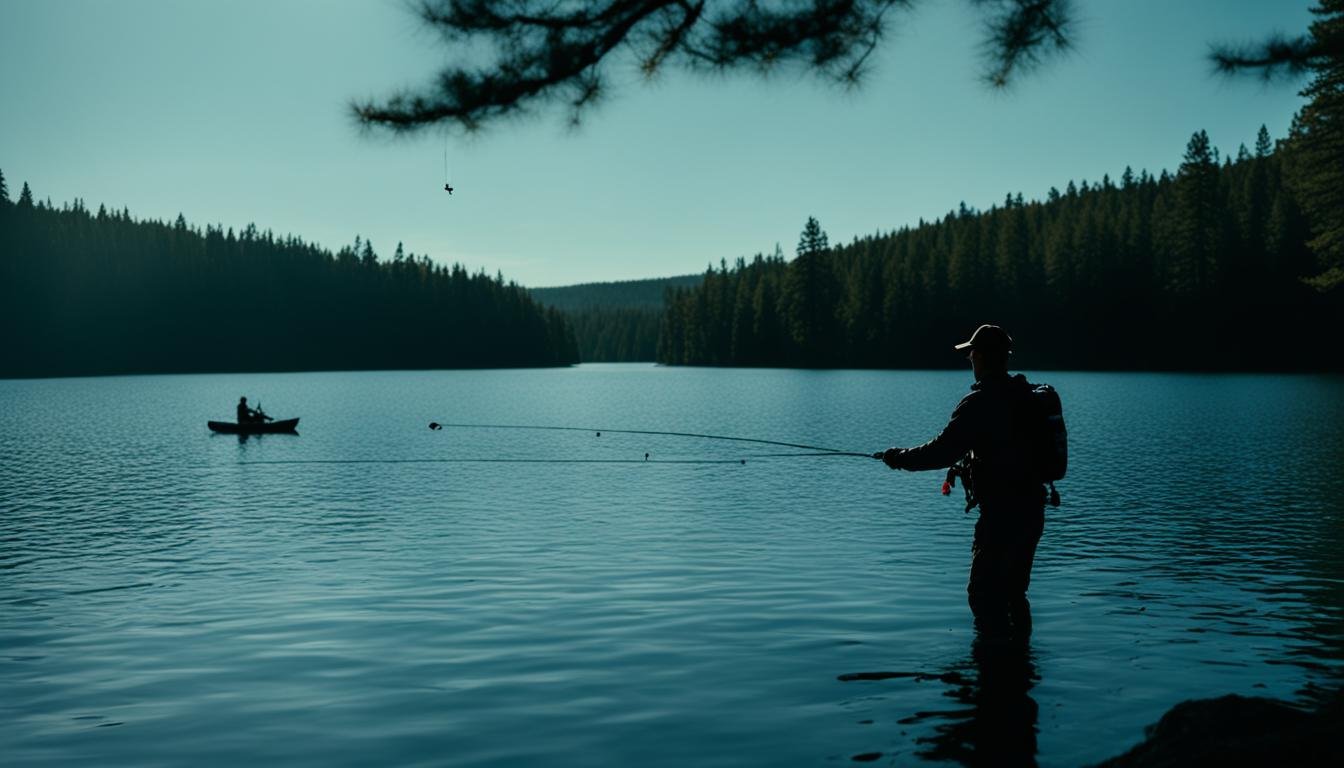Ready to try fishing in Canada? It’s exciting, but safety comes first. Let’s explore key tips for a safe and fun fishing trip.
These guidelines will help beginners enjoy their angling adventures while staying safe on Canadian waters.
Key Takeaways about Essential Fishing Safety Tips for Beginners
- Familiarize yourself with fishing regulations and proper use of fishing gear to stay safe on the water.
- Protect yourself from the elements by wearing appropriate sun protection and staying hydrated.
- Identify potential hazards at the fishing location and share your plans with others for added safety.
- Carry a first aid kit and know basic emergency procedures in case of any accidents.
- Respect the local wildlife and environment by following responsible angling practices.
Introduction to Fishing Safety
Fishing connects you with nature and offers tranquility on the water. For new anglers, safety should be the top concern. Safety precautions prevent accidents and ensure an enjoyable fishing experience.
Importance of Safety Precautions for Beginner Anglers
New anglers must understand the risks of fishing. These include exposure to elements and unpredictable waters. Taking precautions reduces accidents and emergencies.
This allows you to fully enjoy fishing without worry. Safety measures help you focus on the joy of the sport.
Overview of Essential Safety Tips
- Wear a U.S. Coast Guard-approved life jacket at all times when near water to prevent drowning incidents.
- Apply sunscreen with a minimum SPF of 15 every two hours, or more frequently if sweating, to protect your skin from harmful UV damage.
- Stay hydrated by drinking plenty of water, and seek shade to avoid heat-related illnesses.
- Familiarize yourself with the fishing location, identify potential hazards, and share your plans with others.
- Carry a well-stocked first aid kit and learn basic first aid techniques to be prepared for emergencies.
- Respect wildlife and the environment by following local regulations and practicing responsible angling methods.
These safety tips will boost your confidence on the water. You’ll enjoy fishing more knowing you’re prepared. The next section covers specific safety measures for successful fishing trips.
Fishing Safety Tips for Beginners
Preparing for the Weather Conditions
Check the weather forecast before your fishing trip. It’s vital to know the conditions days before and right before you leave. Weather changes can affect your safety and fishing experience. Be ready with the right gear for any weather shifts.
Choosing and Maintaining Proper Fishing Gear
Pick the right fishing gear for safety and success. Include safety items like a life jacket if you’re on a boat. Check your gear often to make sure it works well.
Take care of your equipment to make it last longer. This helps prevent problems that could put you at risk.
Follow these tips to stay safe while fishing:
- Invest in a high-quality, well-fitting life jacket and wear it at all times when fishing from a boat.
- Inspect your fishing line, hooks, and other terminal tackle for any signs of wear or damage, and replace them if necessary.
- Familiarize yourself with the proper techniques for casting, handling, and retrieving your gear to avoid potential injuries.
- Store your fishing equipment in a secure location when not in use to prevent accidental trips or falls.
Choose and maintain your fishing gear carefully. This will help you enjoy your time on the water safely.
Sun Protection and Hydration
Sun protection is vital when fishing. Wearing sunscreen, hats, and protective clothing shields your skin from harmful UV rays. These precautions help prevent painful sunburns.
Wearing Sunscreen, Hats, and Protective Clothing
Choose a sunscreen with SPF 30 or higher. Reapply every two hours or more if sweating or swimming. Some sunscreens are made for fishing, like Bullfrog Quik Gel and Coppertone Sport SPF 50.
Wear hats, hoodies, and long sleeves to protect your skin. Apply sunscreen evenly on all exposed areas, including face, neck, ears, and hands.
Staying Hydrated and Seeking Shade
Bring plenty of water and snacks to stay energized. This helps avoid heat-related issues during long hours in the sun.
Find shade under trees or portable canopies when possible. This reduces sun exposure and provides relief from the heat.
“The recommendation to seek shade when possible enhances sun safety measures.”
Taking sun protection and hydration precautions allows anglers to enjoy fishing while staying safe outdoors.
Familiarizing Yourself with the Fishing Location

Getting to know your fishing spot is key for a safe and fun trip. Look out for dangers and hidden obstacles in the area. This helps you avoid accidents and enjoy your fishing adventure.
Identifying Potential Hazards and Hidden Obstacles
Watch for slippery rocks and strong currents when picking a fishing spot. These can cause falls or dangerous situations if you’re not careful. Check the area for risks before you start fishing.
Fishing can be a relaxing and rewarding activity, but it’s essential to maintain awareness of your surroundings to ensure your safety.
Sharing Your Location with Others
Tell a friend or family member where you’re going fishing. This can be a lifesaver if something goes wrong. They can call for help if needed.
Knowing someone has your back lets you fish with peace of mind.
“Staying safe while fishing is just as important as catching the big one. Familiarize yourself with the area and let someone know where you’ll be – it could make all the difference.”
Understanding your fishing spot and sharing your plans keeps you safe. Being careful lets you focus on having fun and making great memories.
Fishing Safety Tips for Beginners
Safety is crucial for new anglers on fishing trips. By following key precautions, you can enjoy worry-free time on the water. These Fishing Safety Tips for Beginners will help ensure a safe, rewarding experience.
Prepare for Unpredictable Weather
Always check the weather forecast before your trip. Be ready to reschedule if severe conditions are expected. Sudden storms or extreme temperatures can be dangerous for new anglers.
Wear Proper Safety Gear
Beginner Angler Safety starts with a well-fitted life jacket or PFD. Wear it at all times, even if you swim well. Use safety whistles and flashlights to call for help if needed.
Familiarize Yourself with the Location
Take time to know your fishing spot. Look for hazards like hidden obstacles or slippery surfaces. Plan your movements carefully. Share your location and file a float plan for emergencies.
Practice Responsible Angling
Keep your fishing gear in good shape. Store hooks and lures properly to avoid injuries. Be aware of your surroundings and others when casting your line.
Stay Hydrated and Protect Yourself from the Sun
Sun and heat can cause dehydration quickly. Apply sunscreen, wear a hat, and find shade when possible. Drink plenty of water or electrolyte drinks to stay energized.
Following these Fishing Safety Tips for Beginners will boost your confidence on the water. Prioritizing safety leads to a truly rewarding and unforgettable fishing experience.
First Aid Preparedness and Basic Knowledge

Being ready for emergencies is vital when fishing. A first aid kit and basic skills can be lifesavers. Anglers should have the tools and know-how to provide quick, effective care.
Carrying a First Aid Kit
A well-stocked first aid kit is essential for fishing trips. It should have bandages, antiseptic wipes, gauze pads, scissors, tweezers, and needed medications. Keep your kit easy to reach and maintain it after each use.
Key items for your fishing first aid kit include:
- Adhesive bandages in various sizes
- Antiseptic wipes
- Gauze pads and rolls
- Scissors and tweezers
- Pain relievers (e.g., ibuprofen, acetaminophen)
- Antihistamines
- Antiseptic cream
- Medical tape
- Gloves
- CPR mask or face shield
Understanding Basic First Aid Techniques
Knowing basic first aid is crucial for anglers. This knowledge helps you respond quickly to common fishing injuries like cuts, hooks, and sunburns.
Essential first aid skills to learn include:
- Wound care: How to clean, disinfect, and bandage cuts or punctures
- Hook removal: Safely removing a fishing hook embedded in the skin
- CPR and emergency breathing: Providing life-saving assistance in the event of a medical emergency
- Treating environmental injuries: Addressing issues like hypothermia, heat exhaustion, and insect bites
With a good first aid kit and proper skills, you can ensure safety for yourself and others while fishing.
Respecting Wildlife and the Environment
Outdoor lovers must respect nature and its creatures. Responsible fishing means following local rules and using sustainable methods. This keeps our sport alive and ecosystems healthy.
Following Local Regulations and Responsible Angling
Know your local fishing laws before you go. These protect fish populations and keep waters healthy. Follow size limits and catch-and-release policies set by your area.
Use barbless hooks and handle fish gently. Keep fish in water as much as possible. Use a rubberized landing net to reduce stress on fish.
Practicing Catch-and-Release Techniques
Catch-and-release fishing helps maintain healthy fisheries. It protects fish and ensures long-term enjoyment of the sport. Learn proper methods to minimize harm to fish.
Use wet hands when handling fish. Avoid taking fish out of water if possible. Revive fish before letting them go.
Respect rules and use sustainable practices to enjoy fishing responsibly. Your actions today protect fishing for future generations. You can make a lasting impact on wildlife and their habitats.
“Fishing is not just about the catch, but about respecting the delicate balance of the ecosystem. By practicing responsible angling, we can ensure that our sport remains a cherished tradition for years to come.”
10 Interesting Facts about Essential Fishing Safety Tips for Beginners in Canada
- Wearing a life jacket is not just recommended, but required by Canadian law for everyone in a watercraft. Importantly, US-approved life jackets cannot be substituted for Canadian government-approved ones.
- Clear blue ice is generally the strongest for ice fishing, while white, honeycombed ice is only half as strong. This knowledge is crucial for ice fishing safety in Canada’s cold winters.
- Alcohol was involved in 39% of boating deaths in Canada, according to the Canadian Drowning Report 2016 Edition. This highlights the importance of avoiding alcohol while fishing.
- Portable ice huts are considered one of the best pieces of equipment for ice anglers in Canada, offering flexibility to move with fish migrations while providing warmth and comfort.
- Specialized flotation suits or inflatable vests are recommended for ice fishing, providing crucial protection if one falls through the ice.
- In Canada, everyone who operates a power-driven boat needs proof of competency, which can be obtained through a Boat Operator Accredited Training (BOAT) course.
- Cold weather combined with physical exertion can quickly sap energy, making it essential for Canadian anglers to pack snacks and water, especially when fishing in remote areas.
- Proper ventilation is crucial when using heating devices in ice fishing shelters to prevent carbon monoxide buildup.
- For beginners fishing from boats in Canada, keeping the boat neat and organized is a key safety measure. This includes coiling lines neatly and stowing equipment properly to prevent accidents.
- In addition to fishing gear, Canadian anglers are advised to carry safety equipment like flashlights, maps, a cellphone or radio, and electronic SOS devices, as well as visual and sound signals required by the Coast Guard.
These tips emphasize the importance of proper preparation, equipment use, and awareness of environmental conditions for safe fishing in Canada’s diverse waterways.
Conclusion
Safety should be the top concern for new Canadian anglers. Follow these Fishing Safety Tips for Beginners to enjoy a safe fishing trip. Prepare for weather, choose proper gear, and protect yourself from the sun.
Familiarize yourself with the fishing spot and carry a first aid kit. Respect the environment too. These steps ensure a fun and safe fishing experience.
Outdoor Safety for Anglers is vital when fishing. The Beginner Angler Safety tips in this guide will boost your confidence on the water. They’ll help reduce risks linked to fishing.
Safety should be your focus from planning to fishing. This approach leads to a rewarding and safe experience. These guidelines protect you and preserve the ecosystem.
Responsible fishing practices contribute to the sport’s sustainability. They also help maintain the natural resources fishing depends on. By following these tips, you’ll become a skilled and responsible angler.
For an overview about Fishing for Beginners in Canada, please check this guide.
FAQs about Essential Fishing Safety Tips for Beginners
What is required to fish in Canada?
To fish in Canada, you need:
- A valid fishing license appropriate for the province or territory where you plan to fish. Licenses can typically be purchased online through provincial websites or at some retail outlets.
- Familiarity with local fishing regulations, including catch limits, size restrictions, and seasonal rules.
- For non-residents, you may need a non-resident license or an Outdoors Card with a conservation fishing license.
- Awareness of any specific requirements for the body of water you plan to fish, as some areas may have additional regulations.
How do I pack for a Canadian fishing trip?
When packing for a Canadian fishing trip, consider including:
- Appropriate fishing gear (rods, reels, lures, bait) suitable for your target species and fishing technique.
- Weather-appropriate clothing, including layers for warmth and rain gear.
- Sun protection (sunscreen, hat, sunglasses).
- Insect repellent.
- First aid kit.
- Cooler for storing caught fish.
- Camera to document your catches.
- Fishing license and identification.
What is the best month for fishing in Canada?
The best month for fishing in Canada varies depending on the region and target species, but generally:
- Summer months (June to August) are popular for most types of fishing across Canada.
- For salmon fishing, July to September is often ideal, especially in British Columbia and the Great Lakes.
- Ice fishing is popular from December through March in many parts of Canada.
- Spring (April to May) and fall (September to October) can be excellent for many species as water temperatures change.
Where is fishing mostly found in Canada?
Fishing is popular throughout Canada, but some notable areas include:
- The Great Lakes, particularly Lake Ontario, which offers diverse fishing opportunities for species like salmon, trout, bass, and walleye.
- British Columbia’s coastal waters and rivers, known for salmon and halibut fishing.
- Ontario’s numerous lakes and rivers, including Lake of the Woods.
- The Atlantic provinces, especially Newfoundland and Prince Edward Island, for both freshwater and saltwater fishing.
- Alberta’s Bow River, renowned for its trout fishing.
- Quebec’s lakes and rivers, offering a variety of freshwater fishing opportunities.
Remember that fishing opportunities are abundant across Canada, from coast to coast, in both freshwater and saltwater environments.
Why is it important to prepare for the weather conditions when fishing?
Checking the weather forecast is crucial for a safe fishing trip. Unpredictable weather can pose risks, so being prepared is essential. Rescheduling during severe conditions ensures a more enjoyable experience.
What safety equipment should beginner anglers use when fishing?
A life jacket is essential, especially when fishing from a boat. Regularly inspect and maintain your gear. This ensures it will work properly in emergencies.
How can beginner anglers protect themselves from the sun’s harmful UV rays?
Wear sunscreen, a hat, and protective clothing to reduce sun-related risks. Stay hydrated and seek shade when needed. These steps help protect you during a day of fishing.
Why is it important to familiarize yourself with the fishing location?
Be aware of potential hazards like slippery rocks and strong currents. This is crucial when fishing from a boat or wading. Share your location with others for safety in emergencies.
What should beginner anglers have in their first aid kit?
Carry a basic first aid kit and learn how to use it. This helps treat minor injuries during fishing trips. Include supplies for common issues like cuts or hook wounds.
How can beginner anglers practice responsible angling and respect the environment?
Follow local regulations and use catch-and-release techniques. This supports sustainable angling and conservation efforts. Being mindful helps protect natural resources while enjoying fishing.
Source Links
- http://www.ontario.ca/page/learn-fish-guide
- https://www.discoverboating.com/resources/how-to-fish-beginner-fishing-tips
- https://cottagelife.com/outdoors/fishing-101-a-guide-for-beginners/
- https://www.nps.gov/articles/fishing-safety.htm
- https://www.fws.gov/story/guide-fishing-first-time
- https://www.takemefishing.org/how-to-fish/fishing-tips/fishing-tips-for-beginners/
- https://www.boaterexam.com/blog/top-7-tips-for-staying-safe-when-fishing-this-season/
- https://www.crescentspurheliskiing.com/heli-fishing-for-beginners-tips-and-tricks-to-get-started/
- https://www.ontarioparks.ca/parksblog/7-tips-for-introducing-newcomers-to-fishing/
- https://www.fishverify.com/angling-and-sun-protection-what-you-can-do/
- https://www.takemefishing.org/how-to-fish/fishing-safety/fishing-safety-equipment-gear/
- https://www.glidesup.com/blogs/expert-advice/sup-fishing-safety-everything-you-need-to-know
- https://1791edc.com/edc/10-essential-fishing-tips-for-beginners-prepare-for-spring-fishing-season
- https://www.brownellfishing.com/11-beginner-fly-in-fishing-mistakes-to-avoid
- https://www.anglingdirect.co.uk/community/fishing-safety-tips
- https://www.discoverboating.com/resources/safe-fishing-tips
- https://www.lifesaving.org/public-education/water-smart-tips2/boating-and-fishing-safety-tips
- https://www.anglingdirect.co.uk/community/fishing-safety-tips/
- https://www.c2cfirstaidaquatics.com/what-is-marine-basic-first-aid-and-who-needs-it/
- https://premierbodyarmor.com/blogs/pba/basic-preparedness-tips-safety-in-daily-life?page=2
- https://www.emergencyprepgear.com/first-aid
- https://www.stanley1913.com/blogs/how-to-guides/how-to-stay-safe-outdoors-and-recreate-responsibly
- https://www.fws.gov/project/leave-no-trace-principles
- https://bcparks.ca/plan-your-trip/visit-responsibly/wildlife-safety/
- https://www.glidesup.com/blogs/expert-advice/sup-fishing-made-easy-tips-for-beginners
- https://www.nps.gov/subjects/fishing/how-to-safely-catch-and-release.htm
- https://fishmaster.com/blog/post/basic-fishing-skills-and-techniques


